
You’ve heard it time and time again, “Google loves fresh content!” So, if you want your site to be new and trendy in Google’s eyes, you should be continuously updating and altering your website design and content to align with what your users (and search engines) are looking for. However, you may harm the search engine optimizations (SEO) and page authority you worked so hard to build and acquire in doing so. That’s where redirects can help.
Similar to many other technical SEO updates you make to your site, redirects can be harmful if implemented incorrectly or forgotten about. To avoid harmful implications like increased load time, loss of page authority, and poor user experience, follow these tips as we walk through which redirects to use, when to use them, and how to fix common redirect mistakes.
Read through, or jump to a particular section:
How to Create Redirects
How Redirects Affect SEO
Common Redirect Mistakes
To learn even more about SEO, read the Local SEO Checklist.
Common Types of Redirects
To redirect means to send someone or something to a different place. That is exactly what 301 redirects do for webpages. They send users and search engine crawlers from one URL to another.
Redirects help your website pages maintain their importance. Think of it like the mail that comes to your house. The physical mail is the traffic and page authority for your page, and your house is the specific webpage. When you are no longer at the house (e.g. permanently moved, on vacation, etc.), you don’t want to lose the important mail, so you use redirects to indicate where it needs to go instead to preserve its significance.
301 Redirects — Permanent
A 301 redirect is used to indicate when a page has permanently moved from one URL to another. Because this redirect is permanent, the original URL is able to pass along all of the link equity and page authority to the new, redirected page. 301 redirects are preferred by search engines and are the most effective at maintaining SEO advantages.
When a search engine crawler encounters a page with a 301 redirect (say from Page A to Page B), the crawler interprets that Page B is the new Page A. It will then drop Page A from its index and use Page B from now on.
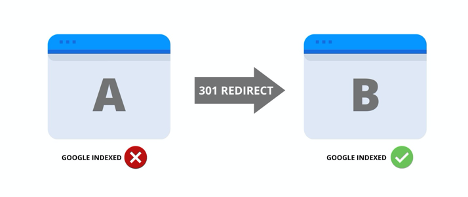
Think of 301 redirects like moving. You move from House A to House B. This is a permanent address change, as you will not be returning to the old house. You fill out a forwarding address card, so the postal service knows you no longer live in House A, and they send all of your mail to House B instead.
It is worth noting that the effects of 301 redirects cannot always be undone. Which means if you set up a 301 redirect, and then remove it, the transfer of authority and link equity will most likely not return to the original page. Always ensure you will no longer need the page before setting up a 301 redirect.
302 Redirects — Temporary
302 redirects indicate a temporary page move. This type of redirect is commonly used when making alterations to the original page or when performing user testing.
Google has recently indicated that 302 redirects are now able to pass along link equity and page authority. Previously, they were not able to, so proceed with caution when using 302 redirects for too long.
Only use 302 redirects if you intend to return to the original page in the near future, otherwise it is better to use a permanent 301 redirect.
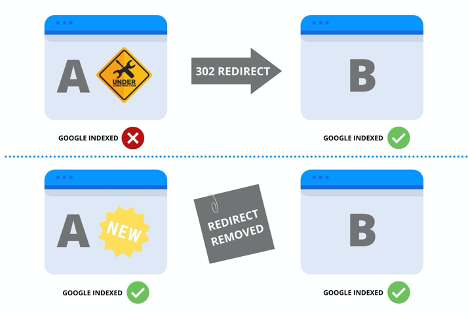
Think of 302 redirects like going on vacation. You leave your house to stay in a hotel for a couple weeks. You ask your neighbor to collect your mail while you are gone. When you return, you bring all the mail back to your house. Your neighbor acts as the temporarily redirected location for your mail.
Wildcard Redirects
Wildcard redirects are used to move multiple pages to a new destination through variable rules.
For example, if you want to move your blog from a subdomain to a subfolder, rather than set up individual 301 redirects for each post, you can set up a wildcard redirect to move everything from blog.bluefrogdm.com to bluefrogdm.com/blog.
Wildcard redirects work by targeting a single changed variable, like a category or subdomain.
You could redirect bluefrogdm.com/blog/local-seo-series to bluefrogdm.com/blog/seo-tips and the wildcard redirect will only affect the URLs with “local-seo” in the path and leave all other URLs (such as bluefrogdm.com/blog/graphic-design) as is.
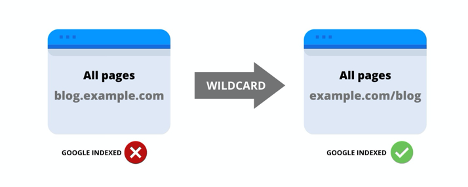 Think of wildcard redirects like merging office locations. For instance, your sales team had their own building a few blocks away, but now you want to move them to the headquarters location. You would be redirecting an entire department to a new location, and everything that comes with it: mail, people, equipment, etc.
Think of wildcard redirects like merging office locations. For instance, your sales team had their own building a few blocks away, but now you want to move them to the headquarters location. You would be redirecting an entire department to a new location, and everything that comes with it: mail, people, equipment, etc.
Note: even though search engines will no longer index the page being redirected, it is important to remove those pages from your XML sitemap. This will ensure your crawl budget is not being wasted on pages that do not need to be crawled.
How to Create Redirects
There are several ways you can create redirects. You can use the .htaccess file on Apache, the .conf file on Nginx, or use WordPress plugins. Regardless of which platform you use, there are similarities in the syntax writing between them. For example:
Apache .htaccess might look like this:
 While Nginx .conf would look like this:
While Nginx .conf would look like this:
 No matter which method you use, the commands tell the server the redirect status code and the action.
No matter which method you use, the commands tell the server the redirect status code and the action.
Status code: “301” and “permanent”
Action: “RedirectMatch” and “rewrite”
In addition, there are Regular Expressions (RegExp) used to indicate other actions, such as:
* matches zero or more of the preceding characters
+ matches one or more of the preceding characters
. matches anything
? matches zero or one time
^ start of the string
| OR operand a or b
These expressions indicate other variations of the redirected URL. For example:
Apache:

Nginx:

The “^” indicates the URL starts with “/old-page”, while the expressions “(/?|/.*)$” means anything following the “/” after “/old-page/” must also be redirected to “/new-page/”. Using these expressions means the following URLs would be redirected:
From: To:
/old-page /new-page/
/old-page/ /new-page/
/old-page/?utm_source= /new-page/?utm_source=
/old-page/child-page/ /new-page/child-page/
Without the regular expressions, any variations from the original URL would end up as 404 pages.
SEO Best Practices for Redirects
Google (and other search engines) have continued to shift focus toward a better user experience, which means they aim to show more reliable, relevant, and high-quality results to users.
With this shift comes a focus on content. Previously, shorter pieces of content were preferred. Now, longer and more comprehensive content that encompasses the topic more in depth are preferred because it provides the user with more information all in one place.
So, what happens to all of those older pages that you worked hard to build rank, authority, and backlinks for?
If you decide to rewrite some of these older pages to provide a more comprehensive view of a topic, you can use 301 redirects to transfer the link equity and authority from the existing pages to your newly created or updated website pages. Here are some SEO benefits to using 301 redirects:
- Google prefers fresh content, so a new or updated page is likely to rank faster and higher than the old page
- Page authority, link equity, and SEO are transferred to the redirected page
- A single page that encompasses a topic more fully is likely to rank for more keywords
When used to better the content on your site, redirects can provide substantial SEO benefits. Here are several ways you can use redirects for SEO purposes and improve your site’s user experience.
Changing Page URL
There are many instances where you may need to change the URL of a page; for example, the name of the product changed, you added a new category, or you are working on optimizing all of your website URLs.
Redirect: bluefrogdm.com/blog/everything-about-301-redirects-you-should-know
To: bluefrogdm.com/blog/301-redirects-best-practice
Whatever the reason may be, using a 301 redirect will tell search engines to index the new URL, while maintaining the page authority, link equity, and rankings of the original.
Deleting Pages
When it comes to deleting pages from your site, there are a few things to consider:
- Is there a similar page you can redirect it to?
- Should the page be improved or optimized?
Whenever possible, you should always redirect a deleted page to a similar piece of content on your site. If that is not an option, you should consider if deleting the page is the best course of action.
For example, if the page receives traffic and has good quality backlinks associated with it, deleting it could be harmful to your SEO, in which case, it may be worth improving and optimizing the page instead.
If there is not a similar page to redirect to, and it is not a page worth optimizing or keeping, you can 404 or 410 the page, but optimize your 404-page display to minimize harm to the user experience.
Altering Site Structure
Changing your site structure can benefit your SEO performance and help search engines understand your website’s content and site categories better.
You can use 301 redirects to change the name of a category or subfolder like this:
Redirect: bluefrogdm.com/marketing-services/inbound-marketing
To: bluefrogdm.com/services/inbound-marketing
This preserves the page authority and link equity already established and transfers it to the new category.
HTTP to HTTPS
Secure websites are important to both users and search engines for establishing trust and privacy. But when you install your HTTPS protocol, you will want to redirect all pages from your HTTP version of the site to the HTTPS version. This will ensure no users or search engines end up on unsecure pages.
Redirect: http://bluefrogdm.com
To: https://bluefrogdm.com
Merging Pages
Merging pages, often referred to as the Cake Technique, is commonly used to clean up old blog posts and create better, more comprehensive content. This process involves identifying pages on your site that are competing for the same keywords and cover the same content.
These types of pages cannibalize your traffic by competing for the same ranking position. As a result, they end up hurting each other and stagnate your rankings.
By updating one of the pages to incorporate the information from both pages, you can then redirect one (or both) to the updated or newly created page.
Redirect: bluefrogdm.com/blog/selling-online-with-social-media
And redirect: bluefrogdm.com/blog/4-ways-to-use-social-media-to-sell
To: bluefrogdm.com/blog/sell-with-social-media
Some benefits of merging pages include:
Higher Word Count – by combining the content on pages, you are likely to increase the word count, which has been correlated to higher rankings.
Resolve Cannibalization Issues – consolidating competing pages prevents Google from having to choose between two pieces of similar content.
Preserved Authority – by using 301 redirects, you will be transferring all of the existing page authority, link equity, and SEO rankings to the new page, thus creating a more powerful page.
Migrating Subdomains
Many SEO specialist argue about if blogs should live on subdomains or subfolders. At the end of the day, if you do migrate a subdomain, you want to preserve and transfer all your pre-built SEO ranking, page authority, and link equity.
Redirect: blog.bluefrogdm.com
To: bluefrogdm.com/blog
Using a wildcard redirect, you can transfer all pages from a subdomain to a subfolder. This makes the process simple and convenient.
Trailing Slash and Upper-Case Issues
Search engines can be very particular about duplicate content and can view variations in a URL as two completely different pages. Trailing slashes and use of upper-case letters are common causes of duplicate content issues.
Using redirects, you can ensure that only one version is accessible, thus resolving the duplicate content issue.
Redirect: bluefrogdm.com/blog/local-seo-series/
To: bluefrogdm.com/blog/local-seo-series
Redirect: bluefrogdm.com/blog/Local-SEO-Series
To: bluefrogdm.com/blog/local-seo-series
There are many ways to use redirects to help boost your site’s overall SEO performance and prevent common issues on your site. However, it is also important to understand common redirect mistakes and how to fix them. These mistakes can be harmful to your site’s authority and user experience.
Common Redirect Mistakes
It can be challenging to keep track of all the redirects in place on your site. Which is why there are free resources, like Screaming Frog’s SEO Spider Tool, to help you identify pages with 301, 302, and 404 status codes, as well as pages involved in redirect chains and loops. Identifying these pages can help you fix and avoid the following redirect mistakes:
Redirecting 404s to Homepage
404 pages have a significant negative impact on user experience. No visitor (or search engine) wants to follow a link that leads to a dead page. However, if redirected, the page needs to go to a similar and relevant new page.
A common mistake is to redirect all 404 pages back to the homepage. Search engines look for redirects to be linked to pages of similar content and relevancy; they will view this as spammy or manipulative behavior, leading them to drop both pages from their index. This means your homepage would no longer appear in search results pages.
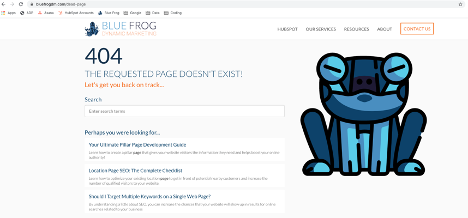
If there are no relevant or similar pages to redirect a 404 page to, it is better to optimize your 404 display. For example, Blue Frog’s 404 page allows the users to click a recent blog article or access any other page from the navigation menu. This minimizes the inconvenience of a 404 status to the user experience and helps keep users on the site.
Redirecting to an Irrelevant Page
Similar to the issue above, search engines can penalize your website pages if you set up irrelevant redirects. For example, if we set up the following redirect:
Redirect: bluefrogdm.com/blog/navigation-menu-tips
To: bluefrogdm.com/blog/graphic-design-logos
Search engines would view this as an irrelevant redirect because the page content does not align. As a result, the page would be treated as a ‘soft 404’ and both would be dropped from search engines’ indexes.
Redirect Chains & Loops
Redirect chains and loops significantly hinder user experience and increase a page’s load time. They also hurt your website’s authority and usability to search engines due to the errors they encounter as they attempt to crawl the pages within the chains and loops.
Redirect Chain: occurs when a page is redirected to another page that is also redirected to a third page.
Redirect Loop: occurs when a page is redirected to itself within a redirect chain.
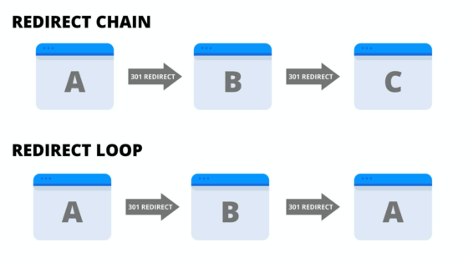 When a page is redirected too many times, or a search engine crawler gets caught in a redirect loop, the search engine will display an error message like this:
When a page is redirected too many times, or a search engine crawler gets caught in a redirect loop, the search engine will display an error message like this:

When users encounter error messages, they promptly leave the site, and are less likely to return in the future. It is important to identify these errors and resolve them immediately.
Redirects have come a long way in their ability to benefit your site. When used correctly, they can provide many advantages as you continuously update and improve your website. Use these tips to correct and prevent redirect errors and keep your website’s SEO intact in the process.



